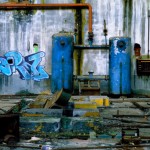Hurricane Sandy and IAQ Series: Why IAQ Will be a Huge Concern in NY and NJ this Spring and Summer
This week we continue our Hurricane Sandy and indoor air quality (IAQ) series as we discuss why IAQ will be a huge concern in New York and New Jersey this spring and summer. In our next post, we’ll share our tips for ways to prepare for extreme conditions.
 As we end the series, we’ll offer our infographic about IAQ and Hurricane Sandy.
As we end the series, we’ll offer our infographic about IAQ and Hurricane Sandy.
In our post Hurricane Sandy and IAQ Series: Top Hurricane Sandy Effects on IAQ this Spring, we talked about how the colder weather hitting the areas affected by the hurricane halted some of the IAQ problems people were experiencing.
Cold weather slows the growth of fungi and bacteria. Additionally, renovations have stopped or at least slowed down, which has also stopped the process of generating dust that can contain asbestos or lead. Any problems attributable to exposure to asbestos or lead are less likely to occur in those areas right now.
So why will IAQ continue to be a huge concern in New York and New Jersey throughout the spring and summer?
As spring hits, and the weather gets increasingly warmer, fungi and bacteria (particularly mold) may start to grow again. Not only that, but renovations to restore hurricane-damaged homes and businesses will start up again.
All this potential exposure to contaminants, including the off gassing of new products after renovations, could lead to an ailment known as sick building syndrome.
Sick building syndrome is defined as “a combination of ailments associated with an individual’s place of work (office building) or residence,” according to Wikipedia. Sick building syndrome is most often related to poor indoor air quality.
Indoor air pollution most often is attributed to contaminants inside the building, according to the National Safety Council.
Mold, as we’ve mentioned before, is one such contaminant. If it’s not properly removed, the people renovating a building as well as any future inhabitants may experience the adverse health effects associated with mold exposure, including allergies, asthma and fungal infections.
Additionally, the National Safety Council explains that other sources of chemical contaminants include adhesives, upholstery, carpeting, insulation, manufactured wood products and cleaning agents. All these materials may emit harmful gases known as volatile organic compounds (VOCs).
VOCs have potentially short- and long-lasting adverse effects on health, and they’re 10 times more concentrated indoors than outdoors, according to the EPA.
Indicators of sick building syndrome include occupants complaining of headaches, dry coughs, dizziness, nausea, fatigue, sensitivity to odors, and irritation of the eyes, nose or throat, says the Ontario Safety Association for Community and Healthcare (OSACH).
With sick building syndrome the symptoms occupants experience can’t be connected to other health issues and those with the symptoms report they’re alleviated once they leave the building.
Some of the solutions OSACH proposes to prevent or treat sick building syndrome include maintaining and regularly cleaning HVAC systems, replacing water-damaged ceiling tiles and carpet, venting contaminant emissions to the outside and increasing ventilation rates.
As renovations are completed due to Hurricane Sandy, OSACH is recommending people allow the building materials in remodeled areas to off-gas before occupants re-enter the building. The organization also recommends using paints, adhesives, solvents and other chemicals only when there are no people in the building.
Fortunately, Goodway can help with products for cleaning HVAC systems and dealing with mold. Read our post Post-Hurricane Sandy Series: Mold and Mildew Management for more about handling mold problems; the post includes a primer on what Goodway products to use.
Next Steps:
- Subscribe to our blog to receive the full blog series via email and stay informed about the latest HVAC news and insight.
- Stay up to date on facility maintenance tools such as chiller tube cleaners, boiler tube cleaners, hose/pipe cleaners, descaler systems, industrial vacuums, commercial pressure washers, and drain cleaners.


Jerry
Very good reading. Very imformative.